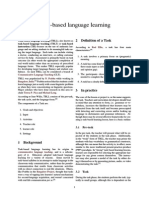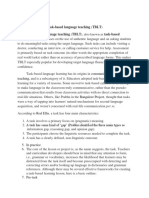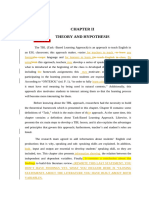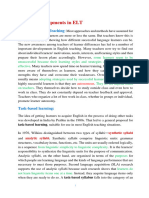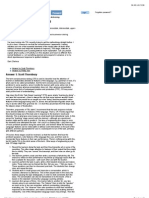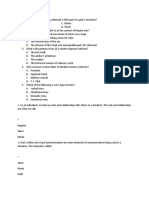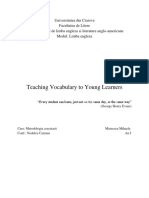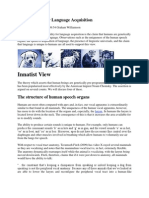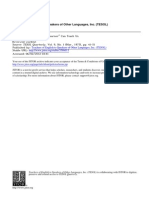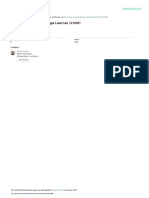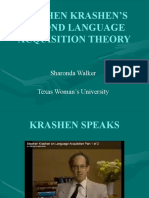3.3 Task-Based Language Teaching (TBLT)
3.3 Task-Based Language Teaching (TBLT)
Uploaded by
Nurul FadilaCopyright:
Available Formats
3.3 Task-Based Language Teaching (TBLT)
3.3 Task-Based Language Teaching (TBLT)
Uploaded by
Nurul FadilaOriginal Title
Copyright
Available Formats
Share this document
Did you find this document useful?
Is this content inappropriate?
Copyright:
Available Formats
3.3 Task-Based Language Teaching (TBLT)
3.3 Task-Based Language Teaching (TBLT)
Uploaded by
Nurul FadilaCopyright:
Available Formats
Task-based language learning
Task-based language teaching (TBLT), also known as task-based instruction (TBI), focuses
on the use of authentic language to complete meaningful tasks in the target language. Such tasks
can include visiting a doctor, conducting an interview, or calling customer service for help.
Assessment is primarily based on task outcome (the appropriate completion of real-world tasks)
rather than on accuracy of prescribed language forms. This makes TBLT especially popular for
developing target language fluency and student confidence. As such, TBLT can be considered a
branch of communicative language teaching (CLT).
Background
Task-based language learning has its origins in communicative language teaching, and is a
subcategory of it. Educators adopted task-based language learning for a variety of reasons. Some
moved to a task-based syllabus in an attempt to develop learner capacity to express
meaning,[1] while others wanted to make language in the classroom truly communicative, rather
than the pseudo-communication that results from classroom activities with no direct connection
to real-life situations. Others, like Prabhu in the Bangalore Project, thought that tasks were a way
of tapping into learners' natural mechanisms for second-language acquisition, and weren't
concerned with real-life communication per se.[2]
TBLT was popularized by N. S. Prabhu while working in Bangalore, India, according to Jeremy
Harmer.[3] Prabhu noticed that his students could learn language just as easily with a non-linguistic
problem as when they were concentrating on linguistic questions. Major scholars who have done
research in this area include Teresa P. Pica, Martin East, and Michael Long.
Definition of a task
A concept, earlier known as the "communicative activity" in 1970s and 1980s[1] was later replaced
by the term task has since been defined differently by different scholars. Willis (1996)[4] has
defined a task as a goal based activity involving the use of the learners' existing language
resources, that leads to the outcome. Examples include playing games, and solving problems
and puzzles etc. Ellis (2003)[5] defines a task as a work plan that involves a pragmatic processing
of language, using the learners' existing language resources and attention to meaning, and
resulting in the completion of an outcome which can be assessed for its communicative function.
David Nunan (2004) draws upon the definitions given by other experts, of two types of tasks:
target tasks and pedagogical tasks. Targets tasks refer to doing something outside the classroom
and in the real world; whereas pedagogical tasks refer to the tasks students perform inside the
classroom and in response to target language input or processing. Nunan concludes that target
tasks may be non-linguistic. He defines pedagogical task as a classroom activity that involves a
student to understand and produce the target language while focusing on conveying the meaning
and not being too concerned with form.[6] On the other hand, Long (1985) defines a task as things
people do in everyday life.[7]
According to Rod Ellis, a task has four main characteristics:[5]
1. A task involves a primary focus on (pragmatic) meaning.
2. A task has some kind of ‘gap’. (Prabhu identified the three main types as
information gap, reasoning gap, and opinion gap.)
3. The participants choose the linguistic resources needed to complete the task.
4. A task has a clearly defined, non-linguistic outcome.
In practice
The core of the lesson or project is, as the name suggests, the task. Teachers and curriculum
developers should bear in mind that any attention to form, i.e., grammar or vocabulary, increases
the likelihood that learners may be distracted from the task itself and become preoccupied with
detecting and correcting errors and/or looking up language in dictionaries and grammar
references. Although there may be several effective frameworks for creating a task-based
learning lesson, here is a basic outline:
Pre-task
In the pre-task, the teacher will present what will be expected from the students in the task phase.
Additionally, in the "weak" form of TBLT, the teacher may prime the students with key vocabulary
or grammatical constructs, although this can mean that the activity is, in effect, more similar to
the more traditional present-practice-produce (PPP) paradigm. In "strong" task-based learning
lessons, learners are responsible for selecting the appropriate language for any given context
themselves. The instructors may also present a model of the task by either doing it themselves
or by presenting picture, audio, or video demonstrating the task.[8]
Task
During the task phase, the students perform the task, typically in small groups, although this
depends on the type of activity. Unless the teacher plays a particular role in the task, the teacher's
role is typically limited to one of an observer or counselor—thereby making it a more student-
centered methodology.[9]
Review
If learners have created tangible linguistic products, e.g. text, montage, presentation, audio or
video recording, learners can review each other's work and offer constructive feedback. If a task
is set to extend over longer periods of time, e.g. weeks, and includes iterative cycles of
constructive activity followed by review, TBLT can be seen as analogous to Project-based
learning.[10]
Types of task
According to N. S. Prabhu, there are three main categories of task: information-gap, reasoning-
gap, and opinion-gap.[11]
Information-gap activity, which involves a transfer of given information from one person to
another – or from one form to another, or from one place to another – generally calling for the
decoding or encoding of information from or into language. One example is pair work in which
each member of the pair has a part of the total information (for example an incomplete picture)
and attempts to convey it verbally to the other. Another example is completing a tabular
representation with information available in a given piece of text. The activity often involves
selection of relevant information as well, and learners may have to meet criteria of completeness
and correctness in making the transfer.
Reasoning-gap activity, which involves deriving some new information from given information
through processes of inference, deduction, practical reasoning, or a perception of relationships
or patterns. One example is working out a teacher's timetable on the basis of given class
timetables. Another is deciding what course of action is best (for example cheapest or quickest)
for a given purpose and within given constraints. The activity necessarily involves comprehending
and conveying information, as in an information-gap activity, but the information to be conveyed
is not identical with that initially comprehended. There is a piece of reasoning which connects the
two.
Opinion-gap activity, which involves identifying and articulating a personal preference, feeling,
or attitude in response to a given situation. One example is story completion; another is taking
part in the discussion of a social issue. The activity may involve using factual information and
formulating arguments to justify one's opinion, but there is no objective procedure for
demonstrating outcomes as right or wrong, and no reason to expect the same outcome from
different individuals or on different occasions.[11]
Reception
According to Jon Larsson, in considering problem-based learning for language learning, i.e., task-
based language learning:[10]
...one of the main virtues of PBL is that it displays a significant advantage over traditional
methods in how the communicative skills of the students are improved. The general ability
of social interaction is also positively affected. These are, most will agree, two central
factors in language learning. By building a language course around assignments that
require students to act, interact and communicate it is hopefully possible to mimic some
of the aspects of learning a language “on site”, i.e. in a country where it is actually spoken.
Seeing how learning a language in such an environment is generally much more effective
than teaching the language exclusively as a foreign language, this is something that would
hopefully be beneficial.
Larsson goes on to say:
Another large advantage of PBL is that it encourages students to gain a deeper sense of
understanding. Superficial learning is often a problem in language education, for example
when students, instead of acquiring a sense of when and how to use which vocabulary,
learn all the words they will need for the exam next week and then promptly forget them.
In a PBL classroom this is combatted by always introducing the vocabulary in a real-world
situation, rather than as words on a list, and by activating the student; students are not
passive receivers of knowledge, but are instead required to actively acquire the
knowledge. The feeling of being an integral part of their group also motivates students to
learn in a way that the prospect of a final examination rarely manages to do.
Task-based learning benefits students because it is more student-centered, allows for more
meaningful communication, and often provides for practical extra-linguistic skill building. As the
tasks are likely to be familiar to the students (e.g.: visiting the doctor), students are more likely to
be engaged, which may further motivate them in their language learning.
According to Jeremy Harmer, tasks promote language acquisition through the types of language
and interaction they require. Harmer says that although the teacher may present language in the
pre-task, the students are ultimately free to use what grammar constructs and vocabulary they
want. This allows them, he says, to use all the language they know and are learning, rather than
just the 'target language' of the lesson.[12] On the other hand, according to Loschky and Bley-
Vroman, tasks can also be designed to make certain target forms 'task-essential,' thus making it
communicatively necessary for students to practice using them.[13] In terms of interaction,
information gap tasks in particular have been shown [by whom?] to promote negotiation of meaning and
output modification.[14][15]
According to Plews and Zhao, task-based language learning can suffer in practice from poorly
informed implementation and adaptations that alter its fundamental nature. They say that lessons
are frequently changed to be more like traditional teacher-led presentation-practice-
production lessons than task-based lessons.[16]
Professional conferences and organizations
As an outgrowth of the widespread interest in task-based teaching, the Biennial International
Conference on Task-Based Language Teaching has occurred every other year since 2005. Past
conferences have been held in Belgium,[17] the United States,[18] England,[19] New
Zealand,[20] Canada,[21] with the 2017 conference scheduled to take place in Barcelona,
Spain.[22] These events promote theoretical and practical research on TBLT. In addition, the Japan
Association for Language Teaching has a special interest group devoted to task-based
learning,[23] which has also hosted its own conference in Japan.
Related approaches to language teaching
• Problem-based Learning (PBL) is a student-centered pedagogy in which students learn
about a subject in the context of complex, multifaceted, and realistic problems.
• Content-based instruction (CBI) incorporates authentic materials and tasks to drive
language instruction.
• Content and language integrated learning (CLIL) is an approach for learning content
through an additional language (foreign or second), thus teaching both the subject and the
language. The idea of its proponents was to create an "umbrella term" which encompasses
different forms of using language as medium of instruction.[24]
• Task-supported language teaching (TSLT) also incorporates tasks as a central part of the
lesson. However, while TBLT follows the pre-task, task, and post-task sequence, TSLT
uses Present-Practice-Produce model as its backbone, then adds a task as an activity to
practice linguistic items in the production stage.[25] In practice, some people still mistake
TSLT for TBTL.
You might also like
- (Preview) Problems in SLA - Michael H. LongDocument43 pages(Preview) Problems in SLA - Michael H. LongKevJY100% (2)
- Background Knowledge of TBLTDocument3 pagesBackground Knowledge of TBLTyessodaNo ratings yet
- Texas Wesleyan University Lesson Plan Format: Teks: Elps: (2) Cross-Curricular Second Language Acquisition/listeningDocument5 pagesTexas Wesleyan University Lesson Plan Format: Teks: Elps: (2) Cross-Curricular Second Language Acquisition/listeningapi-302121503No ratings yet
- Effectiveness of English Subtitled K-Dramas To Gen ZDocument8 pagesEffectiveness of English Subtitled K-Dramas To Gen ZJhy-jhy Orozco100% (2)
- Task Based Learning and Its ExplanationDocument4 pagesTask Based Learning and Its ExplanationSri WirapatniNo ratings yet
- Background: Communicative Language Teaching N. Prabhu Bangalore, IndiaDocument43 pagesBackground: Communicative Language Teaching N. Prabhu Bangalore, IndiaAshe LlampaNo ratings yet
- Task-Based Language LearningDocument5 pagesTask-Based Language LearningAnamaria KasunićNo ratings yet
- Dians TeflDocument3 pagesDians TeflDian IslamiatiNo ratings yet
- Differences Between Task and Activity in The Learning ProcessDocument4 pagesDifferences Between Task and Activity in The Learning ProcessLu Ger Tp Toaquiza Padilla100% (1)
- Task Based Language TeachingDocument13 pagesTask Based Language TeachingSupansa SirikulNo ratings yet
- Mid Term AsignmentDocument10 pagesMid Term AsignmentWinda DNo ratings yet
- Task-Based English Language Teaching .Bibha DeviDocument21 pagesTask-Based English Language Teaching .Bibha DeviBD100% (1)
- Task Based Learning and Competency BasedDocument17 pagesTask Based Learning and Competency Basedmeymirah100% (1)
- Task and Project Work Apr 12Document50 pagesTask and Project Work Apr 12api-251470476No ratings yet
- Task BasedDocument4 pagesTask BasedAri terceroNo ratings yet
- Ayesha... TBLTDocument12 pagesAyesha... TBLTayeshariaz.eltl1302No ratings yet
- Task Based Language Learning - Mazaya Khofifah R (1980002)Document16 pagesTask Based Language Learning - Mazaya Khofifah R (1980002)Endang UtudNo ratings yet
- TBLT - TBI Resumen ActualizadoDocument12 pagesTBLT - TBI Resumen ActualizadoagostinaNo ratings yet
- Chapter IiDocument31 pagesChapter IiismiNo ratings yet
- TBL and PBLDocument3 pagesTBL and PBLrayeneNo ratings yet
- Arguments For and Against Using Task-Based Approach To Foreign Language TeachingDocument5 pagesArguments For and Against Using Task-Based Approach To Foreign Language TeachingMai AvrilNo ratings yet
- Task-Based Approach. Anzid MohammedDocument23 pagesTask-Based Approach. Anzid MohammedAnzid Mohammed100% (1)
- Improving Writing AbilityDocument11 pagesImproving Writing AbilityLukman SianiparNo ratings yet
- Eng. 414 Presentation, Task-Based Language Teaching (TBLT)Document10 pagesEng. 414 Presentation, Task-Based Language Teaching (TBLT)Ruthcie Mae D. LateNo ratings yet
- TBL and PBL Two Learner-Centered ApproachesDocument3 pagesTBL and PBL Two Learner-Centered ApproachesnamavayaNo ratings yet
- NOTE Unit 11 Task-Based Language TeachingDocument73 pagesNOTE Unit 11 Task-Based Language Teachingweijun wuNo ratings yet
- Gound Work - DRDocument16 pagesGound Work - DRThu PhươngNo ratings yet
- What Is TBL?Document3 pagesWhat Is TBL?Dahian VargasNo ratings yet
- TaskbasedDocument9 pagesTaskbasedsinemgulergunNo ratings yet
- Task Based Language TeachingDocument7 pagesTask Based Language TeachingRuthcie Mae D. LateNo ratings yet
- Implementation of Task-Based LearningDocument9 pagesImplementation of Task-Based LearningArafat ShahriarNo ratings yet
- Task in Teaching The Second LanguageDocument2 pagesTask in Teaching The Second LanguageGeraldine BañasNo ratings yet
- TBL and PBLDocument4 pagesTBL and PBLʚϊɞ Sarah Omar ʚϊɞNo ratings yet
- Notes TBLTDocument5 pagesNotes TBLTsinemgulergunNo ratings yet
- The Application of Task-Based Language Teaching To English Reading ClassroomDocument9 pagesThe Application of Task-Based Language Teaching To English Reading ClassroomHari ZajuliNo ratings yet
- Integrated Language Teaching (Autosaved)Document20 pagesIntegrated Language Teaching (Autosaved)Nicole AquinoNo ratings yet
- Sample of A Draft of Theoretical ChapterDocument28 pagesSample of A Draft of Theoretical Chapteras17046No ratings yet
- Task Based LearningDocument6 pagesTask Based LearningJossy Liz García PeñaNo ratings yet
- Making Good Tasks Better: Fundamental Concerns: Iranian Journal of Language Studies (IJLS), Vol. 2 (3), 2008 (Pp. 345-358)Document13 pagesMaking Good Tasks Better: Fundamental Concerns: Iranian Journal of Language Studies (IJLS), Vol. 2 (3), 2008 (Pp. 345-358)عزت بصيريNo ratings yet
- Didactica Parcial 2 ResumenDocument9 pagesDidactica Parcial 2 Resumensms2002arNo ratings yet
- Awanda Novia N. /138/Writing-IVDocument4 pagesAwanda Novia N. /138/Writing-IVAwanda NoviaNo ratings yet
- 3 Current Developments in ELTDocument7 pages3 Current Developments in ELTnazmlk88.88No ratings yet
- Methodology Task-Based LearningDocument3 pagesMethodology Task-Based LearningmllekiwiNo ratings yet
- LessonDocument3 pagesLessonjohnboscookwir3No ratings yet
- Some Advantages and Disadvantages of TaskDocument14 pagesSome Advantages and Disadvantages of TaskHai NguyenNo ratings yet
- A General Overview of Task-Based Language Teaching (TBLT), From Theory To PracticeDocument11 pagesA General Overview of Task-Based Language Teaching (TBLT), From Theory To Practicepeople manNo ratings yet
- Principles of Instructed Second Language AcquisitionDocument6 pagesPrinciples of Instructed Second Language AcquisitionAgatha Nascimento Dos SantosNo ratings yet
- Mata Kuliah: TEFL 1 NAMA: Rusli Abednego NIM: 041674729: 1. Natural Aprroach Teaching MethodDocument7 pagesMata Kuliah: TEFL 1 NAMA: Rusli Abednego NIM: 041674729: 1. Natural Aprroach Teaching MethodRusli AbednegoNo ratings yet
- Sesión 01Document47 pagesSesión 01Fer AlNo ratings yet
- Elements of Communicative Learning TaskDocument10 pagesElements of Communicative Learning TaskFernandoOdinDivinaNo ratings yet
- What Is The Communicative Approach?Document5 pagesWhat Is The Communicative Approach?Brenda PalaciosNo ratings yet
- Task-Based Language Teaching and LearningDocument5 pagesTask-Based Language Teaching and LearningKnd LoboNo ratings yet
- The Communicative ApproachDocument9 pagesThe Communicative Approachema_mirela88100% (2)
- Skills Based SyllabusDocument3 pagesSkills Based SyllabusBernard M. Paderes100% (1)
- LEARNING LOG 4 - July 4th 2023Document6 pagesLEARNING LOG 4 - July 4th 2023angielescano1No ratings yet
- Task-Based Teaching and LearningDocument10 pagesTask-Based Teaching and LearningSol de MardelNo ratings yet
- Tasks and Projects Practice Activity: Students' NamesDocument8 pagesTasks and Projects Practice Activity: Students' NamesmechesNo ratings yet
- Communicative ApproachDocument9 pagesCommunicative ApproachAmal OmarNo ratings yet
- The Implementation of Task-Based Learning Assessment For Assessing Students' Speaking SkillDocument9 pagesThe Implementation of Task-Based Learning Assessment For Assessing Students' Speaking SkillAdhe AgnityNo ratings yet
- Course PlanningDocument5 pagesCourse Planningdunia duniaNo ratings yet
- Task-Based LearningDocument9 pagesTask-Based LearningKatherine MondaNo ratings yet
- English - MajorDocument89 pagesEnglish - MajorCena Jeanette100% (1)
- Makalah Tentang Teaching Listening Skill To Young Learners ThroughDocument8 pagesMakalah Tentang Teaching Listening Skill To Young Learners ThroughIntan KurniasariNo ratings yet
- Thesis Error Analysis Applied LinguisticsDocument7 pagesThesis Error Analysis Applied Linguisticsmarcygilmannorman100% (1)
- Language Learning Strategies Profiles ofDocument290 pagesLanguage Learning Strategies Profiles ofximenagoyenecheNo ratings yet
- Theories of Language AcquisitionDocument16 pagesTheories of Language AcquisitionAhmad BilalNo ratings yet
- 1st Group SLA TBI-DDocument5 pages1st Group SLA TBI-Drosi yantiNo ratings yet
- Assignment On Individual Learner DifferencesDocument11 pagesAssignment On Individual Learner Differencestulip07100% (7)
- Skyteach 40 Handy BooksDocument8 pagesSkyteach 40 Handy BooksData BaseNo ratings yet
- Grammatical Structures of English Module 02Document53 pagesGrammatical Structures of English Module 02Fernand MelgoNo ratings yet
- Teaching Vocabulary To Young LearnersDocument11 pagesTeaching Vocabulary To Young LearnersMihaela TomaNo ratings yet
- ELT Concourse Glossary Methodology Background TermsDocument8 pagesELT Concourse Glossary Methodology Background TermsClaudiaNo ratings yet
- Self ConfidenceDocument24 pagesSelf Confidenceyoujin LeeNo ratings yet
- The Role of Music in The Evolution of LanguagesDocument9 pagesThe Role of Music in The Evolution of LanguagesсашаNo ratings yet
- Innate Ability For Language AcquisitionDocument10 pagesInnate Ability For Language AcquisitionSurayati MuhamadNo ratings yet
- Good Language Learners by Rubin 1975 PDFDocument12 pagesGood Language Learners by Rubin 1975 PDFRick Zepeda100% (2)
- Teaching Poetry Enhances Speaking Skills - An AnalDocument5 pagesTeaching Poetry Enhances Speaking Skills - An AnalLovely RingorNo ratings yet
- Chapter 4Document49 pagesChapter 4robert Ebdao cupinNo ratings yet
- InterlanguageDocument4 pagesInterlanguagekamran khanNo ratings yet
- What Is A Good Language LearnerDocument24 pagesWhat Is A Good Language LearnerJia YiNo ratings yet
- Hasan 2000Document19 pagesHasan 2000Đào UyênnNo ratings yet
- An Overview of Metacognitive Strategies in Reading Comprehension SkillDocument16 pagesAn Overview of Metacognitive Strategies in Reading Comprehension SkillSha MaNo ratings yet
- ENGL102Document22 pagesENGL102mylene almadenNo ratings yet
- 7 VezbaDocument2 pages7 VezbaNinaBegovićNo ratings yet
- Chapter 9 PsycholinguisticsDocument72 pagesChapter 9 PsycholinguisticsKurniawan100% (1)
- Language, Learning and TeachingDocument28 pagesLanguage, Learning and TeachingMaria Ariza RoqueNo ratings yet
- KrashenDocument24 pagesKrashenYaneth Acosta Lafont100% (1)
- Examen Didactica Todo PDFDocument19 pagesExamen Didactica Todo PDFNadia Carrion RodriguezNo ratings yet








